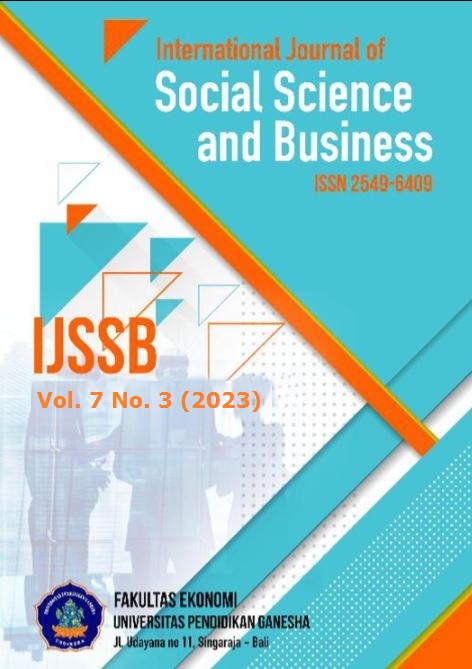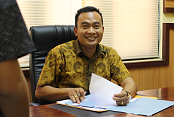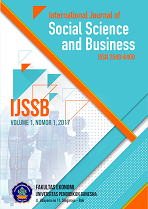Karangkates Railway Tunnel Risk Analysis Based on Ground Penetrating Radar Data
DOI:
https://doi.org/10.23887/ijssb.v7i3.56428Keywords:
Cavity, GPR., TunnelAbstract
The Karangkates railway tunnel in Malang Regency is more than half a century old and has undergone land use changes into settlements and highways. This study aims to identify cavities between the ground surface and the roof of the Karangkates tunnel using Ground Penetrating Radar (GPR) data. Primary data were obtained through GPR measurements and interviews with residents. Qualitative methods are used to analyze GPR interpretation data readings and risk analysis. Risk analysis is carried out to determine the location and area of cavities and compile long-term risk management. From the results of the GPR analysis, 6 points were found with protruding cavities, with a cavity depth between 8 to 13.4 meters. The location of such cavities is in residential areas and highways. Risk management measures appropriate to the analysis and observation of the research site are carried out to reduce the impact of risk. The results showed that the risk value was low. By implication, appropriate corrective and maintenance actions must be taken to mitigate risks and maintain public safety.
References
Adeleke, A. Q., Bahaudin, A. Y., Kamaruddeen, A. M., Bamgbade, J. A., Salimon, M. G., Khan, M. W. A., & Sorooshian, S. (2018). The influence of organizational external factors on construction risk management among Nigerian construction companies. Safety and Health at Work, 9(1), 115–124. https://doi.org/10.1016/j.shaw.2017.05.004. DOI: https://doi.org/10.1016/j.shaw.2017.05.004
Afani, I. Y. N., Yuwono, B. D., & Bashit, N. (2019). Optimalisasi Pembuatan Peta Kontur Skala Besar Menggunakan Kombinasi Data Pengukuran Terestris Dan Foto Udara Format Kecil. Jurnal Geodesi Undip, 8(1), 180–189. https://doi.org/10.14710/jgundip.2019.22555.
Aisyah, L. P., Purnomo, E. P., & Kasiwi, A. N. (2020). Efektivitas Konstruksi Jembatan Layang Sebagai Penguraian Kemacetan dalam Kerangka Smart Mobility di Kota Yogyakarta Tahun 2019 (Studi Kasus Jembatan Layang (Fly Over) Janti). Gorontalo Journal of Government and Political Studies, 3(1), 24–37. https://doi.org/10.32662/gjgops.v3i1.824. DOI: https://doi.org/10.32662/gjgops.v3i1.824
Cambodia, M. (2020). Analisis Gerusan Lokal pada Pilar Jembatan Kereta Api BH. 337 akibat Aliran Sungai Cikao. Teknika Sains: Jurnal Ilmu Teknik, 5(2), 44–53. https://doi.org/10.24967/teksis.v5i2.1085. DOI: https://doi.org/10.24967/teksis.v5i2.1085
Dewantara, M. H. (2020). Peran Transportasi MRT Dalam Mendukung Industri Pariwisata Bisnis Di Jakarta. Journey: Journal of Tourismpreneurship, Culinary, Hospitality, Convention and Event Management, 2(2), 1–24. https://doi.org/10.46837/journey.v2i2.45. DOI: https://doi.org/10.46837/journey.v2i2.45
Gollakota, A. R., Gautam, S., & Shu, C. M. (2020). Inconsistencies of e-waste management in developing nations–Facts and plausible solutions. Journal of Environmental Management, 261. https://doi.org/10.1016/j.jenvman.2020.110234. DOI: https://doi.org/10.1016/j.jenvman.2020.110234
Handayani, D. A., Kurniadi, A., & Bahar, F. (2022). Strategi Pengurangan Risiko Bencana Berbasis Pemberdayaan Masyarakat Desa Penyangga Kawasan Konservasi Taman Nasional Gunung Merapi. Jurnal Litbang Sukowati: Media Penelitian Dan Pengembangan, 6(1), 84–97. https://doi.org/10.32630/sukowati.v6i1.328. DOI: https://doi.org/10.32630/sukowati.v6i1.328
Hermawan, D., & Hamdhan, I. N. (2019). Analisis Geoteknik Terowongan Kereta Api Kebasen Menggunakan Metode Elemen Hingga 3D. Jurnal Komposit: Jurnal Ilmu-Ilmu Teknik Sipil, 3(1), 1–8. https://doi.org/10.32832/komposit.v3i1.3310.
Humaro, R., Karsono, B., Deni, D., Aiyub, H., & Saputra, E. (2023). Workshop: Memahami Peta Topografi dan Kontur Bagi Pelajar Kota Lhokseumawe. Jurnal Solusi Masyarakat Dikara, 3(1), 22–27. https://doi.org/10.1234/jsmd.v3i1.55.
Koesnaryo, S., Vera, T. V., Arindry, A. P. P., & Cholid, M. (2022). Tinjauan Aspek Kerekayasaan Pada Rancangan Terowongan Untuk Sipil dan Tambang. Jurnal Teknologi Pertambangan, 8(1), 48–55. https://doi.org/10.31315/jtp.v8i1.9131. DOI: https://doi.org/10.31315/jtp.v8i1.9131
Lai, W. W. L., Derobert, X., & Annan, P. (2018). A review of Ground Penetrating Radar application in civil engineering: A 30-year journey from Locating and Testing to Imaging and Diagnosis. Ndt & E International, 96, 58–78. https://doi.org/10.1016/j.ndteint.2017.04.002. DOI: https://doi.org/10.1016/j.ndteint.2017.04.002
Liu, B., Zhang, F., Li, S., Li, Y., Xu, S., Nie, L., Zhang, C., & Zhang, Q. (2018). Forward modeling and imaging of ground‐penetrating radar in tunnel ahead geological prospecting. Geophysical Prospecting, 66(4), 784–797. https://doi.org/10.1111/1365-2478.12613. DOI: https://doi.org/10.1111/1365-2478.12613
Mahila, S., Nazifah, N., & Susanti, U. E. E. (2020). Sistem Manajemen Keselamatan dan Kesehatan Kerja Di Perseroan Terbatas Nilam Sari Cipta Amrizal. Legalitas: Jurnal Hukum, 12(2), 248–259. https://doi.org/10.33087/legalitas.v12i2.221. DOI: https://doi.org/10.33087/legalitas.v12i2.221
Maksum, Z. U., Prasetyo, Y., & Haniah, H. (2016). Perbandingan klasifikasi tutupan lahan menggunakan metode klasifikasi berbasis objek dan klasifikasi berbasis piksel pada citra resolusi tinggi dan menengah. Jurnal Geodesi Undip, 5(2), 97–107. https://doi.org/10.14710/jgundip.2016.11526.
Ortega-Ramírez, J., Bano, M., Cordero-Arce, M. T., Villa-Alvarado, L. A., & Fraga, C. C. (2020). Application of non-invasive geophysical methods (GPR and ERT) to locate the ancient foundations of the first cathedral of Puebla, Mexico. A case. Journal of Applied Geophysics, 174. https://doi.org/10.1016/j.jappgeo.2020.103958. DOI: https://doi.org/10.1016/j.jappgeo.2020.103958
Prego, F. J., Solla, M., Núñez-Nieto, X., & Arias, P. (2016). Assessing the applicability of ground-penetrating radar to quality control in tunneling construction. Journal of Construction Engineering and Management, 142(5). https://doi.org/10.1061/(ASCE)CO.1943-7862.0001095. DOI: https://doi.org/10.1061/(ASCE)CO.1943-7862.0001095
Puntu, J. M., Chang, P. Y., Lin, D. J., Amania, H. H., & Doyoro, Y. G. (2021). A Comprehensive Evaluation for the Tunnel Conditions with Ground Penetrating Radar Measurements. Remote Sensing, 13(21), 4250. https://doi.org/10.3390/rs13214250. DOI: https://doi.org/10.3390/rs13214250
Rinaldi, M., Harjanto, A., & Maskuri, F. (2022). Geologi Dan Studi Petrologi Batuan Gunung Api Daerah Giritengah Dan Sekitarnya Kecamatan Borobudur, Kabupaten Magelang, Provinsi Jawa Tengah. Jurnal Ilmiah Geologi PANGEA, 9(1), 53–68. https://doi.org/10.31315/jigp.v9i1.9542.g5337. DOI: https://doi.org/10.31315/jigp.v9i1sp.9412
Sakinah, A. R., & Nugrahani, H. S. D. (2021). The Dynamic Relations of the Northern European Countries and China Within Arctic Corridor Project in Regional Security Complex Perspective. JISIP (Jurnal Ilmu Sosial Dan Pendidikan), 5(4). https://doi.org/10.58258/jisip.v5i4.2435. DOI: https://doi.org/10.58258/jisip.v5i4.2435
Santoso, B., Wijatmoko, B., & Supriyana, E. (2020). Identifikasi Bidang Gelincir Berdasarkan Parameter Fisika Batuan (Studi Kasus: Daerah Rawan Longsor Di Jalan Kereta Api Km 110, Purwakarta). JIIF (Jurnal Ilmu Dan Inovasi Fisika), 4(2), 123–130. https://doi.org/10.24198/jiif.v4i2.27579. DOI: https://doi.org/10.24198/jiif.v4i2.27579
Sedana, D., & Tanauma, A. (2015). Pemetaan akuifer air tanah di jalan ringroad kelurahan malendeng dengan menggunakan metode geolistrik tahanan jenis. Jurnal Ilmiah Sains, 15(1), 33–37. https://doi.org/10.35799/jis.15.1.2015.6778. DOI: https://doi.org/10.35799/jis.15.1.2015.6778
Sehah, S., & Sugito, S. (2017). Analisis Zona Lemah (Amblesan) Di Kawasan Jalan Raya Gunung Tugel Kabupaten Banyumas Berdasarkan Survei Geolistrik Konfigurasi Wenner. Techno (Jurnal Fakultas Teknik, Universitas Muhammadiyah Purwokerto), 17(2), 111–121. https://doi.org/10.30595/techno.v17i2.1404.
Serpella, A. F., Ferrada, X., Howard, R., & Rubio, L. (2014). Risk Management in Construction Projects: A Knowledge-based Approach. Procedia-Social and Behavioral Sciences, 119, 653–662. https://doi.org/10.1016/j.sbspro.2014.03.073. DOI: https://doi.org/10.1016/j.sbspro.2014.03.073
Setyawati, S., & Ashari, A. (2017). Geomorfologi Lereng Baratdaya Gunungapi Merapi Kaitannya Dengan Upaya Pengelolaan Lingkungan Dan Kebencanaan. Geo Media: Majalah Ilmiah Dan Informasi Kegeografian, 15(1). https://doi.org/10.21831/gm.v15i1.16235. DOI: https://doi.org/10.21831/gm.v15i1.16235
Szymański, P. (2017). Risk management in construction projects. Procedia Engineering, 208, 174–182. https://doi.org/10.1016/j.proeng.2017.11.036. DOI: https://doi.org/10.1016/j.proeng.2017.11.036
Toure, S. I., Stow, D. A., Shih, H. C., Weeks, J., & Lopez-Carr, D. (2018). Land cover and land use change analysis using multi-spatial resolution data and object-based image analysis. Remote Sensing of Environment, 210, 259–268. https://doi.org/10.1016/j.rse.2018.03.023. DOI: https://doi.org/10.1016/j.rse.2018.03.023
Trisnawati, Y., & Sunaryo, B. (2014). Keberadaan Moda Transportasi Umum Tidak Bermotor Dalam Mendukung Aktivitas Pariwisata Di Kawasan Malioboro, Yogyakarta. Teknik PWK (Perencanaan Wilayah Kota), 3(4), 1013–1024. https://doi.org/10.14710/tpwk.2014.6812.
Utama, A. G., Wijaya, A. P., & Sukmono, A. (2016). Kajian Kerapatan Sungai Dan Indeks Penutupan Lahan Sungai Menggunakan Penginderaan Jauh (Studi Kasus: DAS Juana). Jurnal Geodesi Undip, 5(1), 285–293. https://doi.org/10.14710/jgundip.2016.10600.
Wilson, D. C., Velis, C. A., & Rodic, L. (2013). Integrated sustainable waste management in developing countries. Proceedings of the Institution of Civil Engineers-Waste and Resource Management, 166(2), 52–68. https://doi.org/10.1680/warm.12.00005. DOI: https://doi.org/10.1680/warm.12.00005
Yang, S., Wang, Z., Wang, J., Cohn, A. G., Zhang, J., Jiang, P., Nie, L., & Sui, Q. (2022). Defect segmentation: Mapping tunnel lining internal defects with ground penetrating radar data using a convolutional neural network. Construction and Building Materials, 319. https://doi.org/10.1016/j.conbuildmat.2021.125658. DOI: https://doi.org/10.1016/j.conbuildmat.2021.125658
Yudhana, W. B. M. (2021). Identifikasi Keberadaan Rongga sebagai Pemicu Amblesan (Sinkhole) Berdasarkan Data Geologi dan Geolistrik Di Daerah Bedoyo, Kecamatan Ponjong, Kabupaten Gunung Kidul. Jurnal Mineral, Energi, Dan Lingkungan, 4(2), 32–45. https://doi.org/10.31315/jmel.v4i2.3446.g3223. DOI: https://doi.org/10.31315/jmel.v4i2.3446
Downloads
Published
How to Cite
Issue
Section
License
Copyright (c) 2022 Abdul Aziz Afif, Wiyono, Abu Bakar Sambah

This work is licensed under a Creative Commons Attribution-ShareAlike 4.0 International License.











